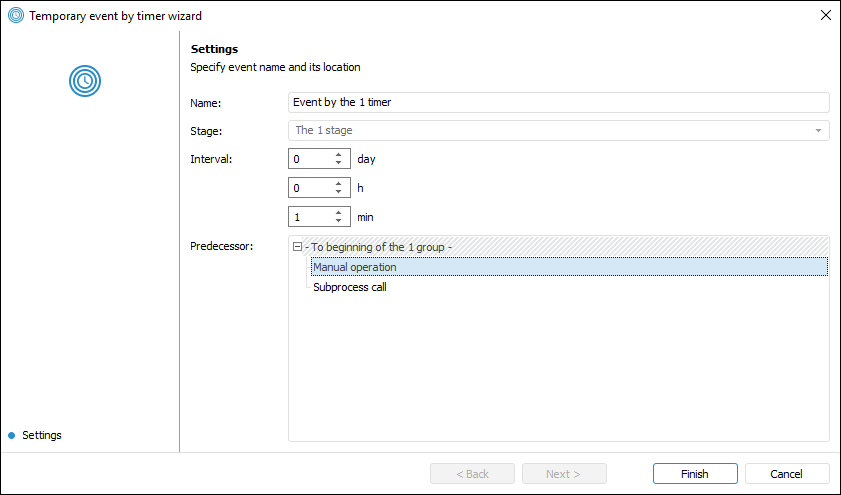Click the ![]() Temporary Event button in the Event group on the Process ribbon tab. and select the
Temporary Event button in the Event group on the Process ribbon tab. and select the  By Timer event type.
By Timer event type.
Select the Temporary > By Timer context menu item in the working area or in the process tree.
When building a process, it is available to set up temporary event by time that enables the user to abort process execution before the time specified in event settings expires. When enabling temporary event, execution of the current process branch is paused till time specified in the event is out.
To add a temporary event in the Set Up Business Process dialog box:
Click the ![]() Temporary Event button in the Event group on the Process ribbon tab. and select the
Temporary Event button in the Event group on the Process ribbon tab. and select the  By Timer event type.
By Timer event type.
Select the Temporary > By Timer context menu item in the working area or in the process tree.
As a result, the Temporary Event by Timer Wizard dialog box opens:

Set the parameters:
Name. Enter event name.
Stage. The box displays the stage where the event is created. The stage is not editable. To add an event to another stage:
Close the wizard, select the required stage or stage step and reopen the wizard.
Finish event creation and move it to the required stage using the  Cut /
Cut / Paste buttons in the Edit group on the Process ribbon tab.
Paste buttons in the Edit group on the Process ribbon tab.
Interval. Enter value of time interval when the process execution must be aborted. The interval can be set in days and/or hours and/or minutes.
Predecessor. Select the predecessor step in the list, after its execution the created event is started. The list is displayed for the second and the following blocks.
NOTE. It is available to set up predecessor step only on creating an event.
The temporary event will be displayed in the working area as a block that is identical to process steps after saving settings.
In the process monitoring working area each event is indicated with the color corresponding to its current status.
Available options of execution status indication:
Grey background. Execution is not started.
Blue background. Event timer is activated.
Green background. Execution is successful.
See also:
Building Process | Creating Stage Steps | Setting Up Stage Steps Execution Conditions